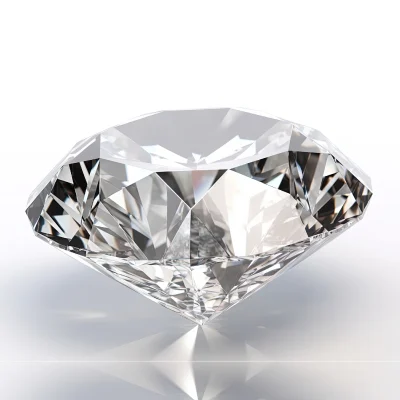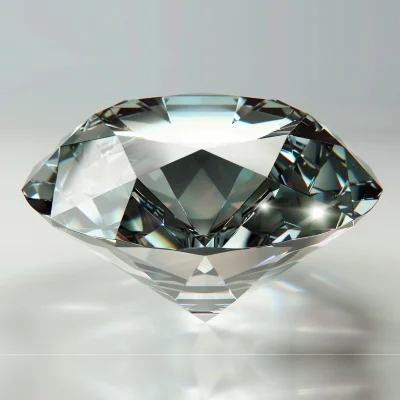
Who doesn’t want to celebrate their special occasion with dazzling pieces of jewelry? The ‘Cubic Zirconia vs Diamond’ debate typically ignites interest in picking a gemstone in jewelry. When one hears the words stunning, rare, and timeless beauty, one can think of the precious diamond. However, natural diamonds come with a steep price tag that isn’t everyone’s cup of tea.
Fortunately, there are excellent alternatives that offer similar brilliance and shine. Cubic Zirconia takes the spotlight on such alternatives. Cubic Zirconia (Cz) is indeed the best alternative for diamonds. Despite their similarities in allure, cubic zirconia and diamonds are pretty distinct in composition, worth, and features.
Let’s learn more about Cubic Zirconia Vs Diamond, a breathtaking face-off!

A Diamond symbolizes purity and light, a sign of love and commitment! Diamonds are carbon solids containing diamond cubic atoms. Its Mohs hardness of 10 makes it the most durable natural substance.
Diamonds are also available in two types: Natural diamonds and Lab-grown diamonds. These two halves of a circle are visibly identical, crystal clear, and made from faceted crystalized carbon.
Natural diamonds result from several years of rigorous forces deep down in Earth’s crust, while lab-grown diamonds were recently made in a lab with the same chemical and physical composition!
Natural Diamonds are made/formed miles below the Earth’s crust. At such a distance, the pressure is about 50,000 times more than the pressure at the surface of the Earth. At such high pressures, the carbon atoms squeeze into each other and form a cubic-like crystalline structure, giving the diamond its shape. This process can take up to millions and billions of years under temperatures reaching 1600 degrees Celsius.
Lab-grown diamonds are made using a synthetic process that imitates natural processes. In this method, pure carbon is pressed into a metal cube while being exposed to immense heat and pressure through electric pulses. Continuous exposure to these circumstances breaks down the carbon crystals to form the crystalline form known as diamonds.

Like diamonds made from carbon, cubic zirconia (CZ) is made from zirconium dioxide (ZrO2). This man-made gem is on par with diamonds in terms of shine and brilliance, earning its name as the ideal diamond simulant. Since CZs are cubic crystalline forms of Zirconium Dioxide, they are a great Diamond lookalike, as diamonds have the same crystalline structure. The CZ stones are too-good-to-be-true gemstones that make you wonder: is cubic zirconia real?
Yes, Cubic Zirconia is real. In its non-processed form, Cubic Zirconia appears in nature as Zirconium Oxide. The natural form of Cubic Zirconia is unstable and quickly breaks down into other crystalline structures. Cubic zirconia has a Mohs hardness of 8 to 8.5, slightly below the diamond’s hardness.
Even though they are not directly mined and are once processed in the labs, CZs are practically real stones with a naturally found rare diamond's brilliance, fire, and durability. Due to such similarities, cubic zirconia is often called Zirconia diamonds.
Knowing how Cubic zirconia is made is important to understanding where CZ gets its beauty. The process starts by melting pure zirconium oxide powder with calcium and magnesium, which act as stabilizers. This mixture is heated at almost 4,298 degrees Fahrenheit until isotropic crystals are formed. After cutting, shaping, and polishing, your beloved cubic zirconia stones are ready to be the limelight of the night.
Cubic Zirconia and Diamonds are nearly identical and almost undetectable to the naked eye. However, upon evaluation and observation, some differences can be spotted.
Here is an easy breakdown of points to help you differentiate between cubic zirconia and diamonds.
| Comparison | Cubic Zirconia | Diamonds |
|---|---|---|
| Appearance | They are free from imperfections and disperse rainbow-colored lights. | They have subtle imperfections and disperse white light. |
| Composition | It is a crystalline form of Zirconium Dioxide (ZrO2), ranking 8.25-8.50 on the Mohs hardness scale. | It is the crystalline form of carbon with a structure called diamond cubic. It is the hardest known stone, ranking 10 on the Mohs scale. |
| Durability | It is less durable and long-lasting than diamonds. | It is the hardest and much more durable than CZ. |
| Cost | Currently, 1-carat cubic zirconia costs around $20. | Currently, 1-carat natural diamond costs around $1,800 - $2,000. |
| Ethical Considerations | Cubic Zirconia is ecofriendly and conflict-free. | Only lab-grown diamonds are conflict-free and sustainable. |
A basic difference you can make while comparing Cubic Zirconia vs Diamond in terms of appearance is that diamonds can have subtle imperfections due to their natural occurrence. These imperfections may include air bubbles, feathers, and internal stress fractures. On the other hand, Cubic zirconia is free from imperfections because it is made under precise conditions.
Furthermore, CZ disperses rainbow-colored lights under sunlight, while diamonds give off white light. This is due to the lower brilliance and refractive index of Cubic zirconia than diamonds.
The composition refers to the chemical composition of CZ and diamond. Diamond ranks 10 on the Mohs hardness scale, making it the hardest known stone in the world. Cubic zirconia's hardness generally ranges from around 8.25 to 8.50, which is highly impressive.
Cubic zirconia’s composition, comprised of optical properties and crystalline form, makes it a captivating gemstone with impeccable elegance and charm!
Compared with naturally found diamonds, cubic zirconia is not a competition in terms of durability. The hardness of diamonds is ranked 10 on the Mohs hardness scale, the hardest of all, while cubic zirconia ranks 8.25-8.50. Thus, cubic zirconia stones are prone to scratches and abrasion over time with the daily wear of an active lifestyle!
Naturally found diamonds and lab-grown diamonds have a marginal difference in their prices. However, it becomes clear why cubic zirconia is an ideal alternative when it comes to the price comparison of CZ with diamonds. Where (currently) 1-carat natural diamond costs around $1,800 to $2,000, and 1-carat cubic zirconia costs only $20. Being extremely cost-effective without compromising on the shine and brilliance!
Here, ethical considerations include sustainability and eco-friendliness of the stones. Natural diamonds are indeed rare and highly valuable; however, their extraction causes extensive damage to the ecosystem. Cubic zirconia and lab-grown diamonds are somewhat conflict-free, as no collateral damage is caused to Mother Earth since they are made in a laboratory.
There it is: deciding on Cubic zirconia vs Diamond depends on personal preferences! To choose the right stone for yourself or gifting, you should learn what they are and how to tell them apart. Knowing the specifications of the stone you are about to buy is essential whether you are a new buyer, a learner, or a market veteran.
We believe that this article has helped you understand the basics of cubic zirconia vs diamonds. Pieces of jewelry made from cubic zirconia are truly beauty and the beast, with the beauty and brilliance of a precious gemstone and a price that rivals that of easily found semi-precious gemstones! However, Diamonds are the most durable and unarguably the best stone for your jewelry, considering their brilliance, fire, and hardness.
Find the perfect stone to reflect your unique personality!